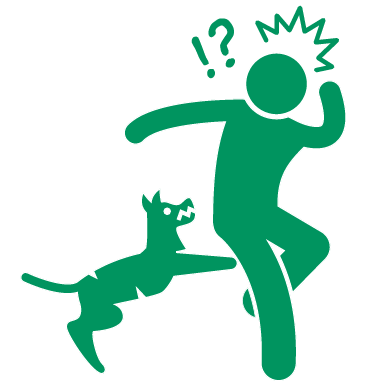
This division works very closely with the Animal Control Divisions, reviews reports of all animal bites to insure proper procedures for confinement, confinement releases and notifications to victims. When animals are not located for confinement or testing, victims receive calls and letters from the EHSS to assure they are aware of the state health department’s position regarding the need for rabies post-exposure treatment. This division also makes the decision to require animal rabies testing when necessary, and prepares the specimens for shipment to the state laboratory
Rabies is a disease caused by a virus that is nearly 100 percent fatal in mammals, including humans. The virus is present in some wild animals and can be spread to pets and humans. The rabies virus is found in the saliva and central nervous tissue of an infected animal. The virus is usually spread through a bite or scratch, but also can be passed along when an infected animal’s saliva or central nervous tissue enters an open wound, mouth, nose or eyes of another mammal.

What you need to know about Rabies. |

Rabies in Animals
Only mammals can get rabies. Birds, fish, reptiles and amphibians cannot get rabies. The most frequently reported wild animals with rabies in Fairfax are raccoons, foxes, skunks and bats. Rabbits, squirrels, rats and mice rarely get rabies. Cats are the most common domestic animal diagnosed with rabies.

Signs of Rabies in Animals
Rabid animals may show strange behavior such as being aggressive, attacking other animals or humans for no reason, or acting tame (this is not a normal behavior in wild animals). Animals infected with rabies may not be able to eat, drink or swallow. As a result, the animal may drool because they cannot swallow their saliva. The animal may stagger or stumble when moving and can become paralyzed. Rabid animals will typically die within a week of developing symptoms.

Protect Yourself, your Family, & your Pets
Vaccination
- Your veterinarian should vaccinate all your dogs, cats, ferrets and horses against rabies. Make sure to follow their instructions on revaccination.
Avoid Contact
- Enjoy wildlife from a safe distance. Do not try and pet wild or stray animals.
- Wild animals should not be kept as pets.
- Keep your pets on your property and away from wild and stray animals. Pets should not be allowed to roam free.
Don't feed wild or stray animals
- Never feed wild or stray animals. Keep all trash covered to avoid attracting animals.
- Feed your pets indoors.
Report strange animal behavior
- Do not go near or try and capture an animal that is acting strangely.

What to do if a person is attacked by a wild, stray, or unvaccinated animal
- Immediately scrub the wounds with soap and running water for 5 to 10 minutes.
- Do not try and kill or capture the attacking animal. However, if you have already killed the animal, avoid further contact even though it is dead.
- Write down a complete description of the attacking animal (e.g., location of the attack and current location of the animal, size, color, unique color patterns, if it was wearing a collar and, if so, what was the color, owner contact information) so that the animal control authorities can properly investigate and take action.
- Seek medical attention at your family doctor or emergency room. Your doctor will check to see if you need rabies post-exposure prophylaxis.
- Report the animal attack to the Fairfax County Police Department by using the Rabies Exposure & PEP Administration Report Form They will help confine or test the attacking animal for rabies.

What to do if your pet is attacked by a wild, stray, or unvaccinated animal
- Do not examine your pet’s wounds without wearing gloves.
- While wearing gloves, wash your pet’s wounds with running soap and water. Be sure to wash off all the attacking animal’s saliva.
- Contact your veterinarian to follow up on additional actions needed to ensure your pet’s health and recovery.

Resources
- Rabies Control - Virginia Department of Health
- Information for Families - Centers for Disease Control and Prevention (CDC)
- Information for Campers and Camp Directors About Bats and Rabies - CDC






